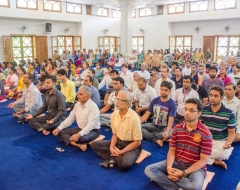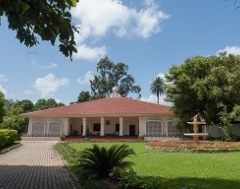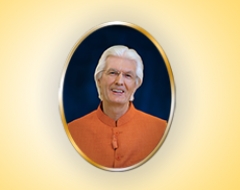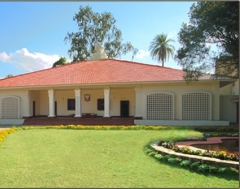Encouraged by his guru, Swami Sri Yukteswarji, Paramahansa Yoganandaji began to systematize the training of young disciples who were interested in leading a spiritual life, while also providing them with basic schooling. At that time two young boys lived at Paramahansaji’s Sadhana Mandir ashram in Kolkata to receive training, and others came regularly to visit. With the enthusiastic patronage of the Maharaja of Kashimbazar, Sir Manindra Chandra Nundy, a formal organizational beginning was made on March 22, 1917, with the founding of Yogoda Satsanga Brahmacharya Vidyalaya with just seven boys at Dihika, West Bengal.

A year later, inspired by the success of the school, which had quickly grown too large for the Dihika site, the Maharaja graciously provided his summer palace and its 25-acre grounds in Ranchi, Jharkhand, where the school was relocated in 1918.
In 1935, when Paramahansaji came to India for a year-long visit, he purchased this property from the Maharaja’s son, Sri Shirish Chandra Nundy. The funding for the purchase came from his disciples in America, his father, and the saved funds from his lectures in America and Europe. Rajarsi Janakananda, the beloved exalted disciple of Paramahansaji and second president of YSS/SRF made a generous donation.
On the pillar of the Main Building in the Yogoda Satsanga Sakha Math, Ranchi are engraved the names of all those who helped in establishing the Ranchi School on a firm footing. Although Guruji seldom openly spoke about the contribution of his father, his father’s help was crucial in the founding of the organization.
A significant renovation of the building was carried out in 1967 by Swami Shyamanandaji. In latter part of 1979, a concrete roof was built and necessary repairs were carried out to restore and safeguard the building for the coming years. The original design and architecture of the building with its sloping roof was retained, also the original wooden beams which can still be seen.
Early Years
In the early years, this building housed the boys’ school. It was a residential school for boys capable of accommodating about a hundred students. The academic programme of the school, which was designed to contribute to the all-round development of the body, mind, and soul of the students, was formulated by Paramahansaji himself. It included agriculture, industrial, commercial, and academic subjects. Following the educational ideals of the rishis, Paramahansaji arranged that most class instruction be given outdoors.
The unique feature at Ranchi was the disciples’ initiation into Kriya Yoga. Regular practices of spiritual exercises, recitation of Gita slokas, and the teachings of the virtues of simplicity, self-sacrifice, honour, and truth were an integral part of the daily schedule.
In addition to his administrative and teaching responsibilities, Paramahansaji played a father-mother role to the children. Sri S. K. D. Banerjee, a student of Yogoda Satsanga Brahmacharya Vidyalaya recalled nostalgically after sixty years: “Paramahansaji was a father to us, and we were his devoted sons. Merely living in his company was spiritual education. Paramahansaji inspired us towards the goal of divine perfection.” While leaving for the West in 1920, Paramahansaji handed over the responsibilities of the children to the other teachers in the school.
By 1968 there were about 1,400 boys and 400 girls enrolled in the YSS High schools and about 800 students in its two colleges. Soon there was a need to shift the educational institutions outside the ashram to meet their growing requirements. Around 1981, boys’ school and college were shifted to a new location – Jagannathpur – around 11 km from the ashram. The main building was then used as office space to meet the growing needs of the organization.
The main building consists of several small rooms and halls – a Reception and Book Room, Matri Mandir, Guruji’s room, and Centenary photo display hall.
Reception Hall
From the outside verandah, one enters into a big hall that serves as a Reception Office for the devotees and other visitors to the ashram. All the publications of YSS are on display and a book sales counter is also located in the hall.
Matri Mandir
Matri Mandir is the large carpeted hall to the left of the verandah. The hall received its hallowed name after the third President and Sanghamata of YSS/SRF, Sri Sri Daya Mata. On one occasion Sri Daya Mataiji went into ‘samadhi’ during a satsanga sitting on one of the divans. Her pictures and the two divans kept in this hall are not only a tribute to Ma, but a reminder to all the Yogodans to the spiritual heights one can attain by regular and sincere practise of Guru-given sadhana. The hall is now being used for the purposes of meditation, counselling, and conducting classes.
Guruji’s Room
The living quarters of Paramahansa Yoganandaji during his early years is preserved as a shrine. The room is situated in the rear portion of the building. The room is open to all for private meditation throughout the day. The room also has a replica of the hand and foot impressions of Guruji.
Names of loved ones needing prayers can be placed inside a prayer box kept on the bed. As a part of the World Wide Prayer Circle started by Guruji during his time, YSS sannyasis and devotees from all over the world pray every day for all those who ask for prayers.
Display of Paramahansa Yogananda’s Personal Items
An exhibit of Guruji’s relics, including the rose flower from his person on the day of his mahasamadhi, is on display in the reception area and in front of the Shrine. Some of the his personal items displayed are
- Umbrella
- Monastic robe and socks
- A piece of “luchi” that he ate
- A rose that had been placed on his body after his mahasamadhi
Exhibition Hall
The Exhibition Hall lies just in front of the reception hall. A pictorial history depicting hundred years’ journey from 1917 to 2016 of Yogoda Satsanga Society of India is on display.




